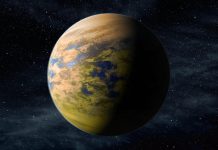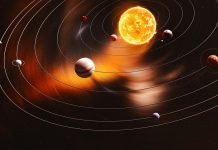
Interest in icy moons has been growing steadily as they become more and more interesting to astrobiologists.
Some take the majority of the attention, like Enceladus with its spectacular geysers.
But there are interesting ones that might be hiding amongst even thicker ice shells in the Uranian system.
A new paper published in Icarus from researchers at the Planetary Science Institute, Johns Hopkins University, and the University of North Dakota, looks at what Ariel, the fourth biggest moon in the Uranian system, might look like under its icy surface.
Unfortunately we don’t have a lot of good quality data on the Uranian moons. The first (and only) time a probe has visited it was Voyager 2 back in 1986.
During that visit it captured the only “up close” images of Ariel, as well as many other Uranian moons, that we’ve ever had.
And when it did so, it was still only able to capture images of the southern half of the Moon, so we’ve never seen the northern half in any detail.
But even with that relatively limited almost 40 year old data set, there are still new discoveries to be made. Modern software helps with that – the team uses two different software systems for geological mapping and stress modeling respectively.
For mapping out Ariel’s surface, the authors turned to ArcGIS Pro, which is typically used to make maps, though not usually from 40 year old data.
With it, the team mapped out major surface features like faults, ridges, and “grabens”, which happen when the crust of a planet drops significantly lower than its surroundings – making it look like a canyon.
Ariel has all of these in abundance, and at a scale compared to its size that dwarfs almost anywhere else in the solar system. Perhaps most notably, there are ancient features, like craters, scattered throughout its surface.
But they also lie right next to relatively “new” features like flat planes of ice that could have been recently released from the moon’s interior.
Each of those features were created by some sort of process – most likely tectonic or cryovolcanic.
To figure out what combination of factors would have resulted in the surface seen today, the team turned to a stress modeling software package specifically designed for Moons – SatStressGUI.
That software defines four different layers of the moon it’s modeling – a rocky core, a liquid ocean, a “ductile” (i.e. not so brittle) ice layer, and an outer, brittle ice layer.
Using that structure, and modifying variables like the orbital eccentricity (how much it deviates from a circle) and obliquity (how much it tilts from a flat plane), as well as the variations of how quickly or slowly the ice shell formed, the researchers came up with a series of stress patterns. They then had to match those patterns up to the results seen in the images from Voyager 2.
It seems that the most likely value for the eccentricity of the orbit was 0.04, which may not sound like much, but it can wreck havoc on the internal composition of the Moon.
In fact, that eccentricity is more than four times that of Europa, which is famous for its jagged surface.
It could have been pushed into that high eccentricity because, billions of years ago, it was likely in a mean-motion resonance (MMR) pattern with Umbriel and Miranda, two neighboring moons. In this setup, where the orbital periods of objects are whole integer ratios of one another, they gravitationally perturb each other regularly.
With that understanding of the evolution of Ariel’s orbit, the authors predict that, at one point in its history, Ariel might have had an ocean around 170 km (~100 mi) deep.
To put that in perspective, the Pacific ocean, on average, is about 4 km (~2.5 mi) deep. So even despite Ariel’s small size at only 1,159 km (720 mi) across, that would make for a pretty large body of liquid water out in the outer solar system.
Given that this analysis was done with 40 year old data on only half of Ariel’s surface, there’s obviously some room for improvement.
However, there’s still no timeline for a mission to the Uranian system that has been funded.
The latest Decadal Survey gave its highest priority to the Uranus Orbiter and Probe, but given the agency’s financial difficulties of late it seems unlikely a completely new mission to a far away planet would get off the ground.
Until we do get another probe out there, Uranian enthusiasts will be stuck analyzing and reanalyzing data that might even be older than they are.
Written by Andy Tomaswick/Universe Today.



